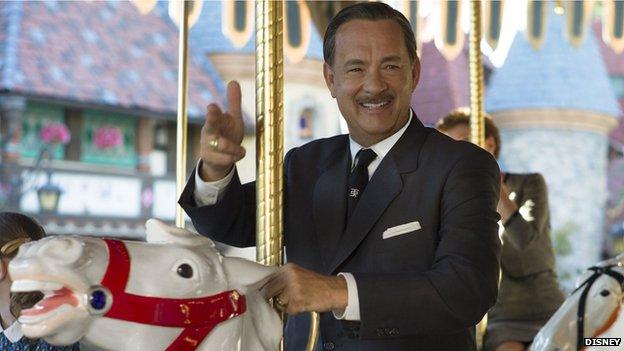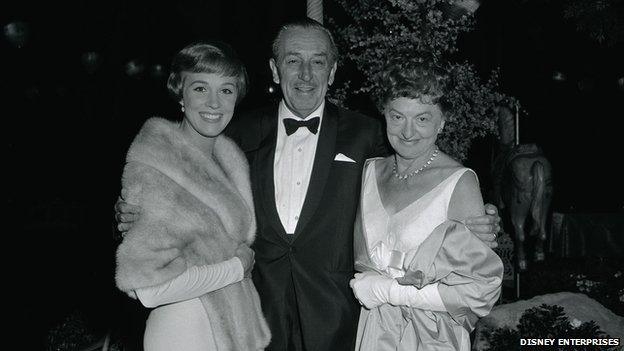Saving Mr Banks and the Disney brand
- Published
Emma Thompson on Hollywood: "I was ravished by it and sort of still am."
Saving Mr Banks, a film about the making of Mary Poppins, contains several scenes you might not expect to see in a Disney film.
One sees Emma Thompson, as Mary Poppins creator PL Travers, arrive in a Hollywood hotel room to find it filled with Disney toys.
She picks up a large stuffed Mickey Mouse and props it in the corner, facing the wall, with the words: "You can stay there until you learn the art of subtlety."
Later we see Walt Disney himself, played by Tom Hanks, hurriedly stubbing out a cigarette and pouring a drink. He even says "damn".
"I was fearful that the folks at Disney would come and say, 'No drinking, no smoking, no cursing - we like Walt better as a god than a human being,'" admits director John Lee Hancock.
"But to their credit, they supported us every step of the way and realised that he was a far more interesting character if he's human."
Walt Disney was a chain-smoker in real life, and the (unseen) stubbed out cigarette is as much as the Disney company - which has a blanket policy against showing lit cigarettes, external in its movies - would allow.
How did Disney bosses feel about the gentle digs elsewhere at their hallowed brand?
Hancock says: "The folks at Disney all laughed at it. They kind of laugh at themselves too - they know 'that's our reputation' and part of it's earned.
"They thought it was funny, I never got any pushback on any of the jokes. There's a line in there where [Travers] says she has no interest in going to Disneyland and it is a money printing machine.
"I thought 'Disney is going to scratch that' - but no, there it is."

No smoking: Tom Hanks as Walt Disney in Saving Mr Banks
Saving Mr Banks is about the real-life battle of wills between Travers and Disney over the movie rights to Mary Poppins.
Thompson admits the prickly novelist has been one of her most difficult roles and describes the author as "deeply contradictory".
Disney had been after the rights to the book for 20 years and the film focuses on a trip Travers makes from London to Hollywood in 1961 to finally discuss the project with Disney face-to-face.
The film also flashes back to Travers' childhood in 1906 Australia and shows how her relationship with her father, played by Colin Farrell, shaped both her career and the character of Mr Banks in Mary Poppins.
With an original screenplay by British writer-producer Kelly Marcel, whose next film project is Fifty Shades of Grey, Saving Mr Banks is the first full-length cinema drama to depict Walt Disney himself.
"I felt that it was going to be difficult to cast - you need to have an icon playing an icon," says Hancock, who directed 2009's The Blind Side, for which Sandra Bullock won a best actress Oscar. "If Tom had said no I'm not sure what we would have done."
Hancock points out that the film is not a Walt Disney biopic. "It's not about him, it's about PL Travers - it's just two weeks in his life in 1961."
Before signing away the book's rights, Travers demanded control over the script and the work of sibling composers Richard and Robert Sherman, whose original songs in the film included A Spoonful of Sugar and Let's Go Fly a Kite.

(From left) Julie Andrews, Walt Disney, and PL Travers at the Mary Poppins film premiere in 1964
The author, who died in 1996, so disliked the Oscar-winning Disney production that she never allowed any more Mary Poppins books to be adapted into films.
How did Mary Poppins, with its mix of live action and animation, feature in Hancock's childhood?
"I'd seen the movie several times, so it was part of my childhood, but it wasn't a movie I watched every year or I dearly loved. I recognise it as as a real step forward from a technological standpoint. The songs are fantastic and contagious."
Although Travers did give Disney the film rights in 1961, it wasn't until 1964 that the film was released. It went on to receive 13 Oscar nominations and won five - for best actress (Julie Andrews), best effects, best film editing, original score and original song.
The last two best picture winners at the Academy Awards - The Artist and Argo - have been Hollywood movies about movie-making, so the signs are good for Saving Mr Banks. It is being widely tipped as an Oscar nominee.
"I'd love to tell you that I'm not aware of what's going on but I don't live in a cave," says Hancock. "But I'm excited that people seem to like the movie, and Emma and Tom are fantastic. We've got an amazing cast so anything that lifts them up, I'm all for it."
Saving Mr Banks is out in the UK on 29 November and in the US on 13 December
- Published21 October 2013
- Published20 October 2013
- Published20 October 2013
- Published20 October 2013